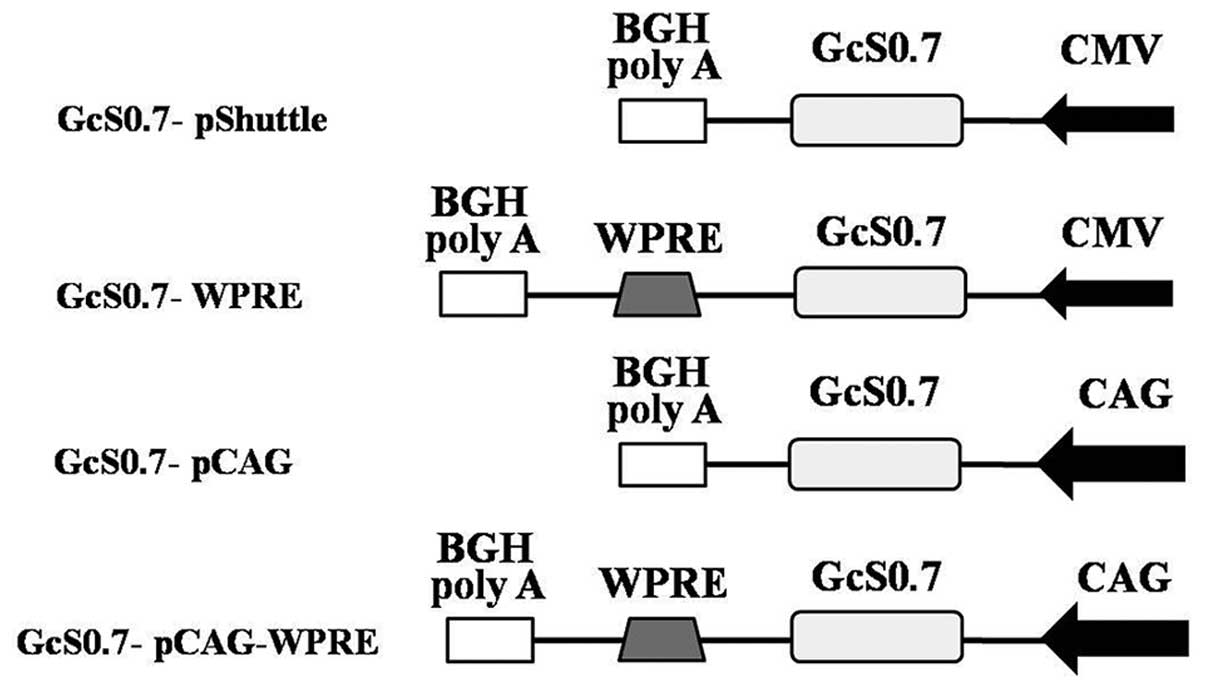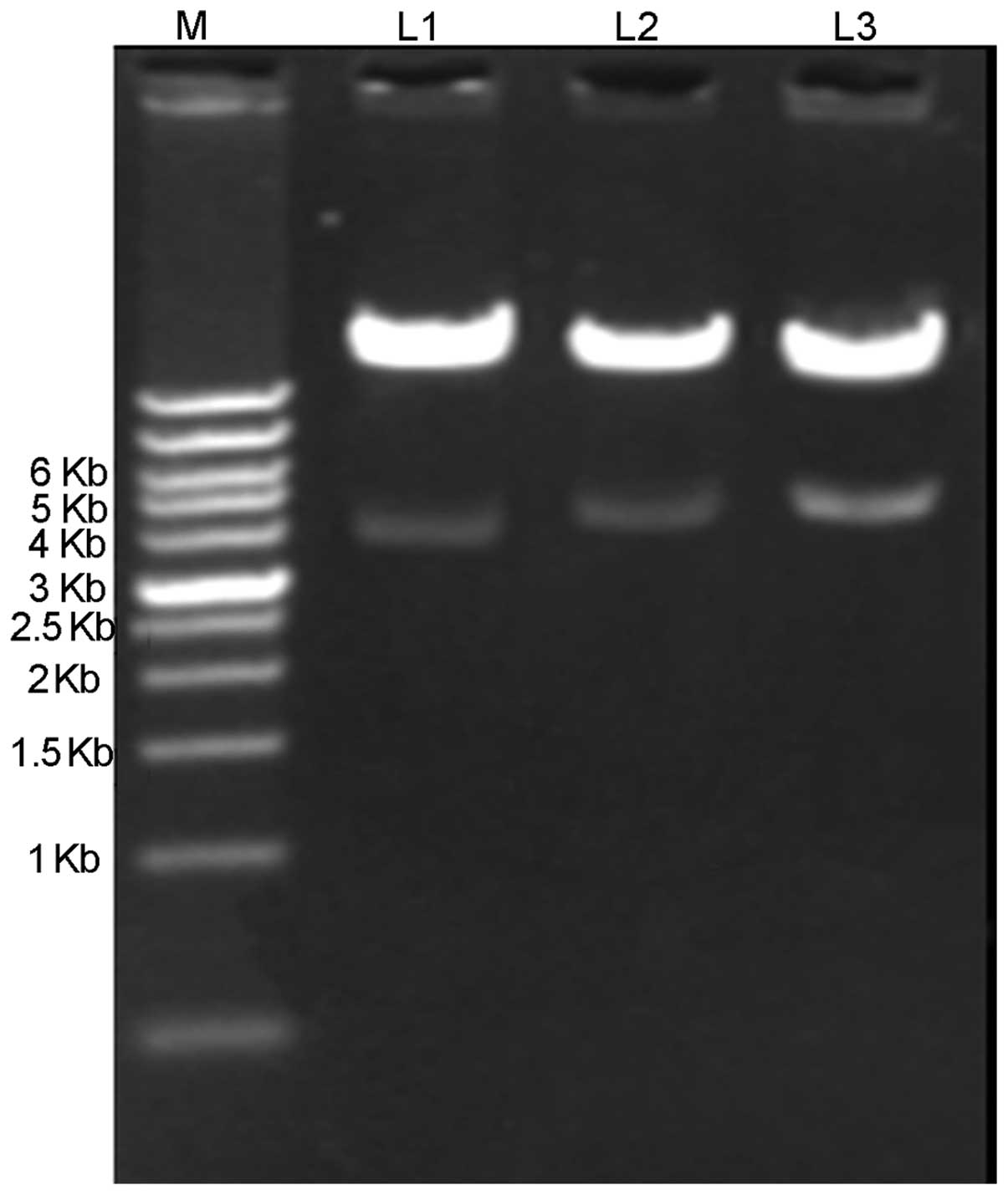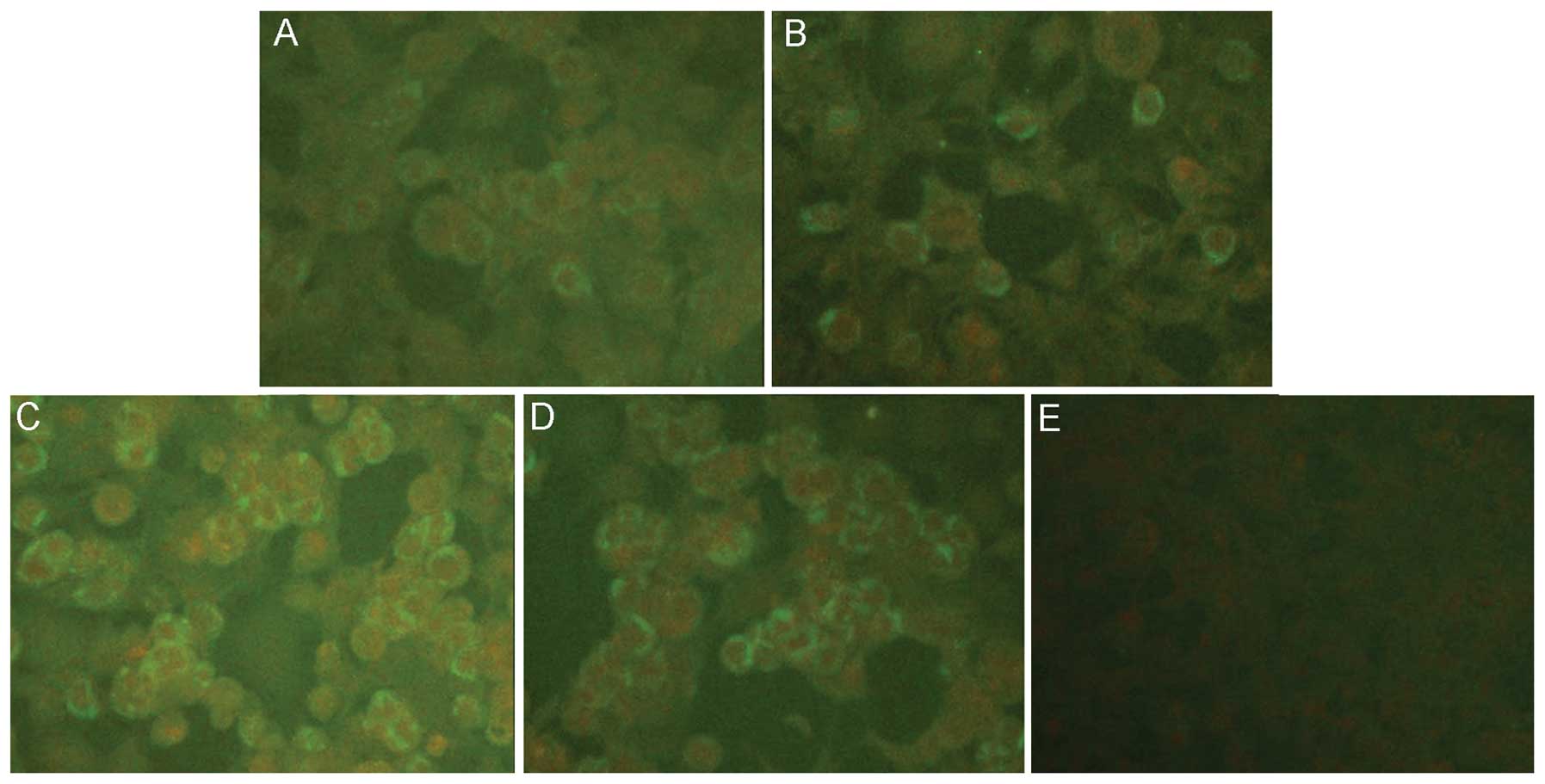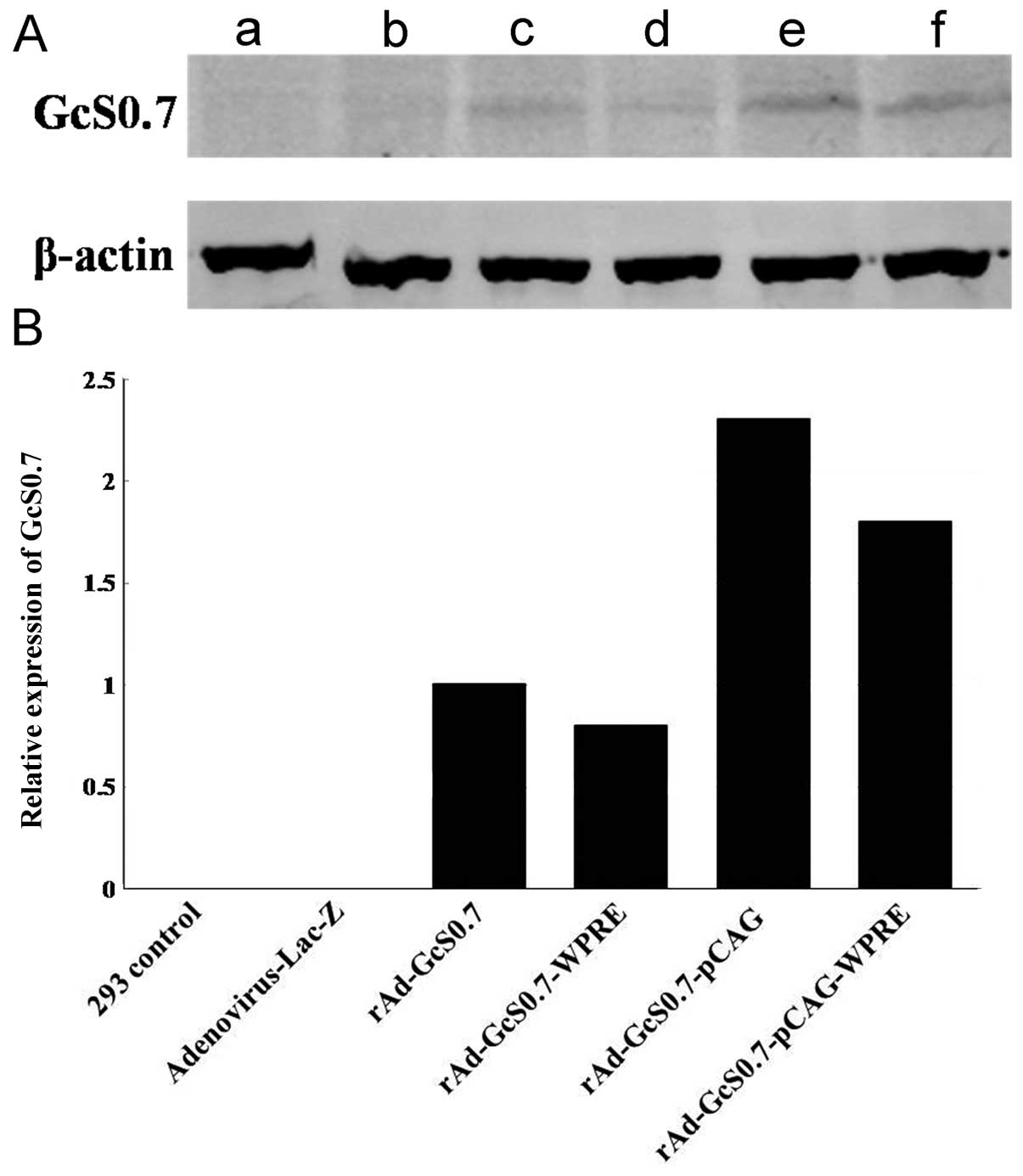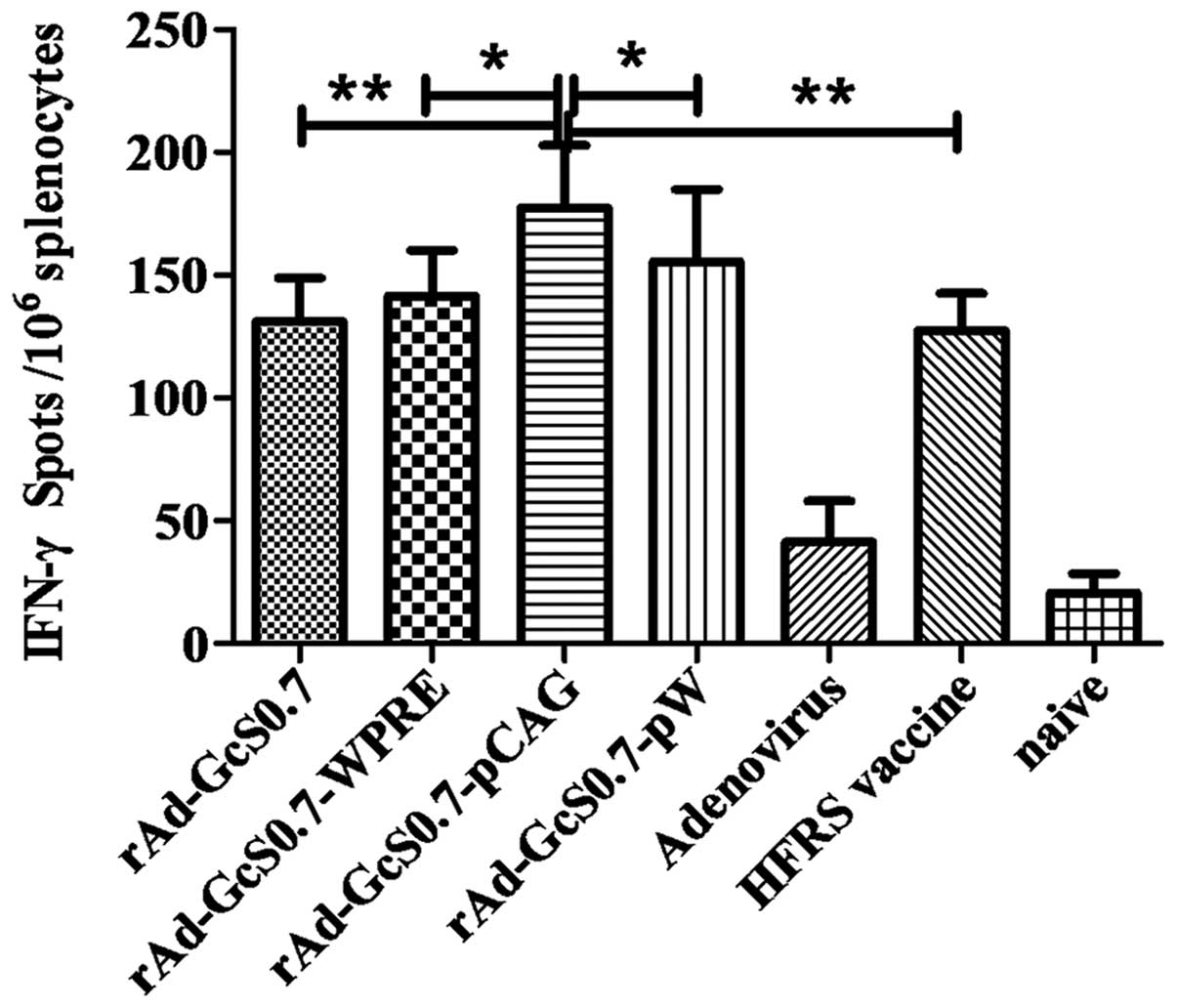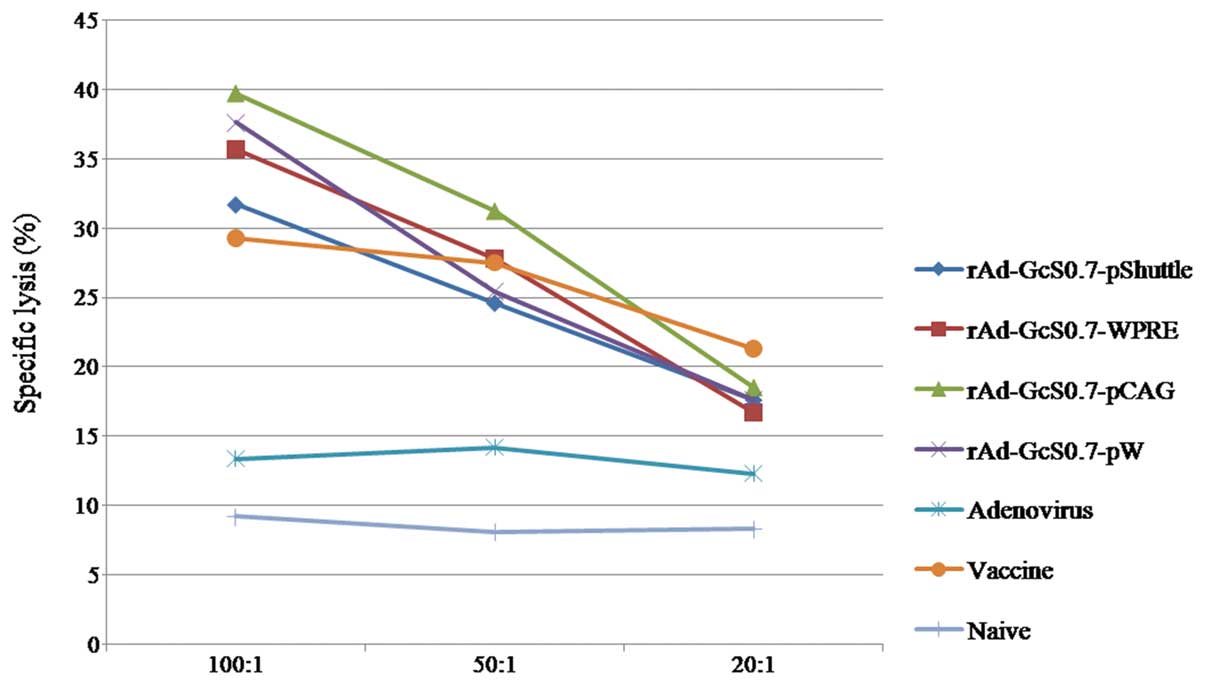Induction of Hantaan virus-specific immune responses in C57BL/6 mice by immunization with a modified recombinant adenovirus containing the chimeric gene, GcS0.7
- Authors:
- Published online on: June 20, 2013 https://doi.org/10.3892/ijmm.2013.1421
- Pages: 709-716
Abstract
Introduction
Hantaviruses are enveloped RNA viruses with a diameter varying from 70 to 350 nm (1), which form a genus within the Bunyaviridae family. The viral genomes are tri-segmented, negative sense RNA. Hantavirus genome segments are designated as large (L), medium (M) and small (S). The L segment encodes an RNA polymerase. The M segment encodes an envelope glycoprotein precursor cleaved to form 2 surface glycoproteins, Gn and Gc. The S segment encodes the nucleocapsid protein (NP) (2). To date, more than 23 hantavirus species have been identified (3).
Hantavirus infection is manifested as 2 different forms of severe febrile diseases, hemorrhagic fever with renal syndrome (HFRS) and hantavirus pulmonary syndrome (HPS) (4). Hantaan virus (HTNV), Seoul virus (SEOV), Puumala virus (PUUV) and Dobrava virus (DOBV) cause HFRS; Sin Nombre virus (SNV), New York virus (NYV), Black Creek Canal virus (BCCV), Bayou virus (BAYV), Laguna Negra virus (LNV) and Andes virus (ANDV) cause HPS (5). Human infection by hantaviruses can result in profound morbidity and mortality; the HFRS mortality rate varies from 0.1 to 10%, while HPS has a mortality rate of 40 to 50% (6). Hantavirus infection can also cause potentially long-term cardiovascular consequences (7). More than 90% of HFRS infections occur in Asian countries and the most severe forms of HFRS are mainly caused by HTNV infection (8). In China, inactivated vaccines have been produced by using rodent brain and cell cultures (9). Although the protective efficacy of several inactivated vaccines has been confirmed, there are still unresolved issues concerning their production and human use. The viral yield obtained from virus-infected cell cultures is low and hantaviruses require high-level safety conditions for handling. In terms of safety and yield, recombinant vaccines should be able to overcome these disadvantages.
Both humoral and cellular immunity play important roles in virus clearance during hantavirus infection. The 2 glycoproteins, Gn and Gc, are presumed to be the major elements involved in the induction of neutralizing antibodies during hantavirus infection. Monoclonal antibodies (mAbs) directed against Gn and Gc have displayed virus-neutralizing activity in vitro as well as in vivo (10). Cellular immunity is believed to be associated with the hantavirus NP (11). Although anti-NP antibodies do not display neutralizing activities, studies have shown that immunization with NP induces a protective immune response which can increase the survival of mice following challenge with a lethal dose of hantavirus (12). It has been suggested that the protection afforded by anti-NP antibodies is mediated by the induction of antibody-dependent cytotoxic T cells. Therefore, utilization of both the glycoprotein and NP components for vaccine development may prove to be a promising approach. The N-terminus of the NP contains major hantavirus antigenic epitopes, in particular in the 0.7-kb fragment of the S segment (13). Mice immunized with the GnS0.7 fusion protein (Gn of the M segment and a 0.7-kb fragment of the S segment) and the GcS0.7 (Gc of the M segment and a 0.7-kb fragment of the S segment) elicit anti-NP, anti-glycoprotein and neutralizing antibodies. In addition, mice immunized with these fusion proteins also elicit better cellular immune responses than mice immunized with the unfused proteins (14,15).
In the vaccine development process, improving antigen expression is the most important aspect that should be considered. Antigen expression can be improved at both the transcriptional and post-transcriptional levels. The human cytomegalovirus (CMV) immediate-early enhancer/promoter is the most commonly used promoter in DNA vaccines; however, the activity of this promoter varies among different tissues and cell lines and gene expression driven by the CMV promoter has been shown to be downregulated in the presence of interferon (IFN)-γ (16). The hybrid CMV enhancer/chicken β-actin (CAG) promoter shows higher antigen expression than the CMV promoter and therefore, this promoter has been universally adopted in DNA vaccine research. The woodchuck hepatitis virus (WHV) contains a post-transcriptional regulatory element (WPRE) (17), which increases the stability and extranuclear transport of mRNA to the cytoplasm, resulting in enhanced protein production. Several studies have shown that WPRE increases transgenic expression from a variety of viral vectors (18–20). An earlier vaccination study using DNA vaccines that include either CAG or WPRE demonstrated that compared with conventional CMV vectors, the vaccines including CAG or WPRE increased immune responses to increased antigen expression (21).
In previous studies, transgenic expression from adenoviral vectors has been optimized by the incorporation of CAG and WPRE (22). With the optimization of promoter and transcriptional regulatory elements in adenoviral vectors, the expression of the fusion protein encoded by the chimeric gene, GnS0.7, was promoted. Humoral and cellular immunity was also enhanced in mice immunized with optimized adenoviral vectors containing GnS0.7. In this study, we promoted the expression of the fusion protein, GcS0.7, by using the strong CAG promoter and the powerful post-transcriptional response element, WPRE, either together or individually. The effects of these 2 elements were compared by cloning the fusion protein and elements into the reconstructed adenoviral vectors and packaging recombinant adenoviruses. The immunogenicity of recombinant adenoviruses incorporating CAG or WPRE or both was also examined by the immunization of C57BL/6 mice. Based on the results of this study, we expect to find an effective means of amplifying the immune response which elicits protective immunity against HTNV.
Materials and methods
Antibodies, cells and culture medium
The human embryonic kidney (HEK) 293 cell line (ATCC No. CRL-1573; ATCC, Manassas, VA, USA) and B16 murine melanoma cells (B16F10, ATCC no. CRL-6475) were maintained in Dulbecco’s modified Eagle’s medium (DMEM; Gibco, Grand Island, NY, USA) supplemented with 10% fetal bovine serum (FBS; HyClone, Logan, UT, USA). Vero E6 cells (Vero C1008, ATCC no. CRL-1586) were maintained in RPMI-1640 (Invitrogen, Carlsbad, CA, USA) supplemented with 10% fetal calf serum (FCS; Gibco). All cells were incubated at 37ºC in 5% CO2. The HTNV strain 76–118 was used in this study. mAb 1A8 (HTNV NP-specific), mAb 3G1 (with a high neutralizing activity against HTNV) (23), HFRS patient serum, Sp2/0 ascites and purified NP were all provided by our laboratory. Purified HTNV glycoprotein was purchased from the Lanzhou Institute of Biological Products, Lanzhou, China. Female C57BL/6 mice (6–8 weeks old) were purchased from the Animal Center of the Fourth Military Medical University, and housed in ventilated cages. All animal experiments were conducted in accordance with the procedures described in the Guide for the Care and Use of Laboratory Animals (NIH Publications no. 80–23, revised 1978).
Construction of modified vectors and recombinant adenoviruses
The chimeric gene, GcS0.7, the recombinant plasmid, GcS0.7-pShuttle, and the recombinant adenovirus containing GcS0.7 (rAd-GcS0.7-pShuttle) were constructed as previously described by Professor Fang-Lin Zhang of our laboratory (24). The CAG (GenBank accession no. EF186086.1) sequence was synthesized with appropriate restriction enzyme sites and inserted into the GcS0.7-pShuttle at the MfeI and NheI restriction sites, while the synthesized WPRE (GenBank accession no. AX823860.1) fragment was inserted at the KpnI and AflII sites. The reconstructed vectors were designated as GcS0.7-WPRE, GcS0.7-pCAG and GcS0.7-pCAG-WPRE. The expression units were cloned into the PI-SceI and I-CeuI sites of the pAdeno cosmid that contained the genome of adenovirus type 5 without the E1 and E3 regions. The positive recombinant adenoviral DNA was linearized by PacI and transfected into early-passage HEK 293 cells using Lipofectamine 2000 according to the manufacturer’s instructions. The recombinant adenoviruses designated as rAd-GcS0.7-WPRE, rAd-GcS0.7-pCAG and rAd-GcS0.7-pCAG-WPRE were amplified and purified using the ViraBind™ Adenovirus Purification kit (Cell Biolabs, Inc., San Diego, CA, USA), and their titers were determined using the Adeno-X™ Rapid Titer kit (Clontech, Mountain View, CA, USA). The adenovirus Lac-Z and rAd-GcS0.7-pShuttle were prepared in the same way. The final preparations were stored at −80ºC.
Identification and comparison of GcS0.7 expressed in different recombinant adenoviruses
The GcS0.7 fusion protein of different recombinant adenoviruses was identified by immunofluorescence assay (IFA). The HEK 293 cells were plated in 24-well plates at a density of 2×105 cells/well−1 24 h before infection and were persistently infected with recombinant adenoviruses at a multiplicity of infection (MOI) of 100 pfu/cell for 4 h. Following infection, fresh medium was added and the infected cells were incubated at 37ºC in 5% CO2 for 48 h. By aspirating the medium, the cells were allowed to dry in the hood for 5 min and fixed by very gently adding ice-cold 100% methanol followed by incubation at −20ºC for 10 min. mAb 1A8 and FITC-labeled goat anti-mouse IgG antibody were used as the detecting antibodies. After thorough washing, the infected cells were observed under a fluorescence microscope. To determine which recombinant adenoviruses had the highest expression level of the fusion protein, GcS0.7, the HEK 293 cells were persistently infected 24 h post-plating in 6-well plates at a MOI of 100 pfu/cell for 4 h. After a further 48 h of incubation, the cells were harvested for western blot analysis, and detected with mAb 1A8 and the IRDye 800 anti-mouse IgG antibody. All experiments were repeated, and similar results were obtained each time.
Immunization of mice
Female C57BL/6 mice were randomly divided into 7 groups, including 4 experimental groups and 3 control groups; each groups comprised 5 mice. The experimental groups were immunized with 0.5 ml 108 pfu/ml recombinant adenovirus per mouse, while the control groups were immunized with 0.5 ml physiological saline, 0.5 ml 108 pfu/ml Adeno-X-Lac-Z or 10 μl HFRS inactivated vaccine per mouse. All the immunizations were administered 3 times at 2-week-intervals. Mouse sera were collected individually via tail vein puncture at 2 and 4 weeks from the first day of immunization or by retro-orbital plexus puncture 10 days after the final immunization. Additionally, splenocytes were isolated for subsequent tests.
Antibody detection
In the present study, 3 types of antibodies were detected, including the anti-NP, anti-glycoprotein and neutralizing antibody against HTNV. Indirect enzyme-linked immunosorbent assays (ELISA) were used to detect NP and glycoprotein-specific antibodies. Purified NP or glycoprotein was used as the coating antigen, HRP-labeled goat anti-mouse antibody was used as the detection antibody and OPD was used as the substrate. The colorimetric reaction was terminated by the addition of 2 M H2SO4, and the optical density (OD) at 490 nm was determined using a standard ELISA plate reader. The antibody titers were defined as the reciprocal of the serum dilution with the highest positive response. Neutralizing antibodies were detected by cell microculture neutralization tests. The heat inactivated sera were serially diluted 2-fold from 1:5 in RPMI-1640 containing 2% FCS, and combined with an equal volume of 100 TCID50 (median tissue culture infective dose) HTNV (76–118 strain). Following incubation at 37ºC for 90 min, 100 μl/cell of the mixture was applied to monolayers of Vero E6 cells followed by further incubation at 37ºC for 9 to 11 days in a 5% CO2 incubator. Thereafter, the cells were lysed by 3 consecutive freeze-thaw cycles. The presence of HTNV antigen in the cell lysates was detected by sandwich ELISA with mAb 1A8 used as a coating antibody, and HRP-conjugated 1A8 used as the detection antibody. The mAb 3G1 and Sp2/0 ascites were used as the positive and negative controls, respectively. The absorbance was measured at 490 nm using a standard ELISA plate reader. The neutralizing antibody titer was defined as the maximum dilution of serum that inhibited HTNV infection in 50% of the cells.
Detection of IFN-γ secretion by T cells
The enzyme-linked immunospot (ELISPOT) assay was used to determine the amount of T cells capable of responding to IFN-γ stimulus. Mice were sacrificed and orbital blood samples were collected 10 days after the final booster immunization. Spleen cells were purified in lymphocyte separation medium. Freshly isolated splenocytes (1×106 cells in 100 μl) were added into each well of pre-coated IFN-γ plates (Mabtech AB, Stockholm, Sweden), and stimulated with purified HTNV glycoprotein antigen (10 μg/ml), or the positive stimulator, concanavalin A (ConA; 4 μg/ml). Splenocytes incubated with 100 μl 2% FCS DMEM were used as the negative or background controls. These plates were incubated at 37ºC for 18 h. Cytokine ELISPOT assays were carried out according to the manufacturer’s instructions. Spots were counted using an ELISPOT reader system (Cellular Technology Ltd., Hong Kong, China), and the results were expressed as the mean number of specific IFN-γ spot-forming cells per 1×106 splenocytes.
Cytotoxicity assay
The cytotoxicity of GcS0.7-specific cytotoxic T lymphocytes (CTLs) was determined using the CytoTox 96™ Non-Radioactive Cytotoxicity Assay kit (Promega, Madison, WI, USA) in accordance with the instructions of the manufacturer. Splenocytes from mice immunized with recombinant adenoviruses or sham-inoculated mice were prepared as previously described and used as effector cells, while B16 cells transfected with GcS0.7-pCDNA3.1 and screened by G418 were used as the target cells, with normal splenocytes as the negative control. The target B16-GcS0.7 or B16 cells were plated at 1×104 cells/well in 96-well U-bottomed plates and effector splenocytes were then added at effector:target (E:T) ratios of 20:1, 10:1 and 5:1 in a final volume of 100 μl. Following 4 h of incubation at 37ºC and 5% CO2, the cytotoxicity assay plates were centrifuged at 250 × g for 5 min, and 50 μl aliquots from all wells were transferred to fresh 96-well flat-bottom plates, and an equal volume of reconstituted substrate mix was added to each well. The plates were incubated in the dark at room temperature for 30 min. Subsequently, 50 μl of the stop solution were added, and the absorbance values at 490 nm were measured. The percentage cytotoxicity was calculated according to the following formula: % cytotoxicity = [(E - St - Se)/(M - St)] ×100 [E, effector-target co-culture cells lactate dehydrogenase (LDH) release; St, target cell spontaneous LDH release; Se, effector cell spontaneous LDH release; M, target cell maximum LDH release].
Statistical analysis
Statistical analysis was performed using GraphPad Prism software version 5.0. One-way ANOVA was used to determine statistically significant differences among the experimental groups. Student’s t-tests were used to determine significant differences between experimental and control groups. A value of P<0.05 was considered to indicate a statistically significant difference.
Results
Identification of modified vectors and recombinant adenoviral DNA containing GcS0.7
In this study, we modified the pShuttle vector with the chimeric gene, GcS0.7 (GcS0.7-pShuttle), as follows: i) replacement of conventional human cytomegalovirus immediate-early promoter/enhancer (CMV) of pShuttle with the hybrid CMV enhancer/chicken β-actin promoter (CAG); ii) replacement of the enhancer/promoter in conjunction with the mRNA post-transcriptional regulatory element of the woodchuck hepatitis virus (WPRE); iii) single insertion of WPRE upstream of the 3 pShuttle stop codons (Fig. 1). The accuracy of cloning in each of these constructs and packaging of recombinant adenoviruses was confirmed by restriction enzyme (Fig. 2) and polymerase chain reaction (PCR) analysis.
Immunofluorescence assay detecting the target proteins expressed by recombinant adenoviruses
After purification, the recombinant adenoviruses containing the chimeric gene, GcS0.7, were concentrated to 1010 pfu/ml. HEK 293 cells infected with the recombinant adenoviruses were examined by IFA using mAb 1A8 (Fig. 3). Positive fluorescence was observed in the cells 48 h after infection. The most intense fluorescence due to the expression of the target protein, GcS0.7, was observed in the cells infected with the vector containing the CAG promoter and with the CAG promoter in conjunction with WPRE. The fluorescence due to the expression of GcS0.7 from the vector incorporating only WPRE was less intense than the other 2 vectors.
Comparison of the fusion proteins expressed by recombinant adenoviruses
Western blot analysis was performed to investigate the fusion protein expression levels. Equal amounts of GcS0.7 extracted from the HEK 293 cells infected for 48 h were separated on a 12% SDS-polyacrylamide gel and analyzed by western blot analysis using mAb 1A8. The proteins extracted from the non-infected HEK 293 cells and from adenovirus-Lac-Z-infected cells were used as the controls. A specific protein band of approximately 80 kDa was bound by mAb 1A8, which was consistent with the molecular weight of the GcS0.7 fusion protein. The western blot analysis results further demonstrated that the expression efficiency of the CAG hybrid promoter/enhancer was greater than that of the other groups: the expression of GcS0.7 from rAd-GcS0.7-pCAG was 2.3-fold greater than that from the unmodified rAd-GcS0.7 vector (Fig. 4).
Specific humoral immune responses elicited by recombinant adenoviruses
The geometric mean titer (GMT) values (glycoprotein and NP-specific) of mice immunized with rAd-GcS0.7-pCAG were the highest among all recombinant adenovirus groups; (69.6 and 139.3, respectively). The GMT (glycoprotein and NP-specific) values of mice immunized with the HFRS inactivated vaccine were 160 and 640, respectively (Tables I and II). As shown in Table III, the recombinant adenovirus generated immune sera against the 220
220HTNV strain 76–118 showed neutralizing titers ranging from 10 to 40, of which the titer values of rAd-GcS0.7-pCAG were higher than those of the others
Similar levels of neutralizing antibodies were detected in the inactivated vaccine immunized group, while the sera from the control and Adeno-Lac-Z groups showed no obvious neutralizing activity. These results suggest that immunization with recombinant adenoviruses carrying GcS0.7 elicits neutralizing antibodies as efficiently as the inactivated vaccine.
Cellular immune responses elicited by recombinant adenoviruses
The frequency of splenic CD8+ T cells secreting IFN-γ from the immunized mice was detected by ELISPOT assay. As shown in Fig. 5, adenovirus-Lac-Z and the naïve control induced negligible IFN-γ responses. By contrast, all recombinant adenoviruses expressing the fusion protein induced an effective IFN-γ response, and among these, the group immunized with rAd-GcS0.7-pCAG had a significantly higher response compared to the other groups. The specific T cell-mediated cytotoxicity of vaccination-activated splenocytes was detected using the CytoTox 96 Non-Radioactive Cytotoxicity assay, whereby the release of LDH from attacked HTNV GcS0.7-expressing B16 cells is measured. As shown in Fig. 6, splenocytes from the mice immunized with recombinant adenoviruses containing GcS0.7 exhibited variable levels of specific cytotoxicity against the B16-GcS0.7 cells (P<0.05), and the cytotoxicity was enhanced with the E/T ratio, which was the most significant at the ratio of 100:1. Among all the experimental groups, splenocytes from the mice immunized with rAd-GcS0.7-pCAG showed higher specific cytotoxicity compared to the other groups at E/T ratios of 100:1, 50:1 and 20:1 (P<0.05). The cytotoxicity from the rAd-GcS0.7-pCAG immunized mouse spleens was even greater than that from the mice immunized with the inactivated vaccine at E/T ratios of 100:1 and 50:1 (P<0.05). By contrast, the non-specific cytotoxicity against the B16-GcS0.7 cells of the control mice immunized with adenovirus-Lac-Z or NC was very weak at E/T ratios of 100:1, 50:1 and 20:1.
Discussion
Hantaviruses are distributed worldwide and cause serious human diseases. Until now, rodent brain and cell culture-derived inactivated hantavirus vaccines have been used in South Korea and China (25). Although the inactivated vaccines have demonstrated promising protective effects, there are still unresolved issues concerning their production and human use: the titers of virus-neutralizing antibodies were found to be low and to possess low immunogenicity (26). Furthermore, the preparation of inactivated vaccines requires high-level safety conditions. Thus, there is still a need to improve these vaccines to generate stronger and more long-lasting immune responses.
In hantavirus infections, both humoral and cellular immunity are involved in protection. As enveloped viruses, hantavirus Gn and Gc glycoproteins are able to induce virus-neutralizing antibodies which are sufficient for protection against virus challenge in animal models (27). The Gc glycoprotein of hantaviruses and of other members of the Bunyaviridae family directs the viral fusion activity and is therefore classified as a class II viral fusion protein (28). Thus, antibodies against Gc may play a significant role in preventing viral entry into the cell. The role of CTLs in the elimination of hantavirus-infected cells was also observed in vivo and in vitro. The CTL response was directed against the NP.
Previous studies have indicated that recombinant vaccines based on adenoviral vectors expressing both glycoprotein and NP may be able to overcome the defects of conventional hantavirus vaccines. With the help of the expression-regulating elements, CAG and WPRE, the expression of the recombinant adenovirus chimeric gene, GnS0.7, elicited high-level immune responses of both the humoral and cellular type. Mice immunized with rAd-GnS0.7-pCAG demonstrated the highest immunity of all the groups (22).
The effective expression of protein antigens is the basic requirement in vaccine development. With their many advantages over other vectors, adenoviral vectors were used in this study. Recombinant adenoviruses containing the chimeric gene, GcS0.7, were constructed with the CAG promoter and WPRE used as substitutes for the original CMV promoter in the commercial adenoviral vector to increase the expression of the fusion protein, GcS0.7. The fusion protein, GcS0.7, was detected in all recombinant adenovirus groups by western blot analysis and IFA, with both the CAG promoter and WPRE elements shown to act separately to boost the expression level of the fusion protein compared with the conventional CMV promoter-based viral vector. Recombinant adenoviruses containing the CAG promoter showed the highest expression level and a synergistic effect of the 2 elements was not observed in our study. An earlier vaccination study using DNA vaccines that include either CAG or WPRE demonstrated that compared with conventional CMV vectors, the vaccines including CAG or WPRE increased immune responses to increased antigen expression (21). The WPRE has been shown to enhance transgenic expression driven from a series of different promoters in various vector and cell types at the post-transcriptional level (10,18). However, certain studies have shown conflicting, even opposing effects of the WPRE due to differences between cell lines and promoters (29). In our previous study, the combination of the CAG promoter/enhancer and WPRE did not produce the highest expression levels of the fusion protein among all groups in HEK 293 cells (22). The data obtained in this study were consistent with this phenomenon. The CAG and WPRE did not show a synergistic effect, which may be attributed to the inhibitory effect of WPRE on the CAG promoter activity during transcription.
To further evaluate the correlation of the immune responses with the fusion protein expression level, we investigated both the humoral and cellular immune responses in C57BL/6 mice immunized with recombinant adenoviruses or inactivated vaccine. The antibody titers against the glycoprotein and NP of mice immunized with rAd-GcS0.7-pCAG were the highest among all experimental groups. Antibody titers of the mice immunized with the HFRS inactivated vaccine were higher than those generated by any of the recombinant viral vectors. Neutralizing antibodies are key effectors involved in protection against hantavirus infection. Our results revealed that immunization with recombinant adenoviruses carrying GcS0.7 elicited equivalent neutralizing antibody responses compared with the inactivated vaccine, thus indicating that recombinant adenoviruses can elicit the same protection as inactivated vaccines. The elevated antigen expression leading to improved humoral immunity through incorporation of the CAG promoter into the adenovirus expression system has also been confirmed by other studies. Richardson et al demonstrated the improved expression of Ebola glycoprotein from adenoviral vectors by using the CAG promoter and showed that immunization of mice with the improved recombinant adenovirus resulted in enhanced B cell immune responses (30).
As cellular immune responses are also important in limiting viral infection and replication, the hantavirus-specific cellular immune responses were further assessed in vitro. During hantavirus infection of humans there is a mixed Th1/Th2 response, where the Th1 type response is induced mainly by NP and the Th2 response is induced by the Gn/Gc glycoproteins (10). The significant role of NP-induced CTL in the protection against viral infection is well established, and to further evaluate the cell-mediated immune responses we focused on the Th1 type response in this study. The antigen-specific production of IFN-γ has been promoted as a quantitative marker of Th1-type protective cell-mediated immune responses. Additionally, IFN-γ is a very important cytokine for the maturation of natural killer (NK) cells, which contribute to innate immune responses against viruses. During hantavirus infection, when kidney failure and pneumonia are 2 main symptoms, an increased number of NK cells in the kidneys or lung tissue would accelerate hantavirus clearance. In this study, ELISPOT assay analysis of the IFN-γ production by hantavirus-specific CTLs showed that rAd-GcS0.7-pCAG stimulated higher IFN-γ release after immunization compared with that detected in the other experimental groups and the vaccine control. Although the IFN-γ ELISPOT assay is widely adopted for the measurement of IFN-γ secretion to demonstrate specific CTL reactivity, this method is limited in that IFN-γ can also be released by non-cytotoxic cells involved in innate and adaptive immune responses (31). To overcome this deficiency, the CytoTox 96 Non-Radioactive Cytotoxicity assay was used to measure the frequency specific target cell lysis by CTLs in order to assess the T cell functional activity. All the recombinant adenoviruses used in this study were shown to induce specific cytotoxic effects on the target cells, with the strongest effects induced by rAd-GcS0.7-pCAG in comparison with the other experimental groups and even the vaccine control at E/T ratios of 100:1 and 50:1 (P<0.05). This may be attributed to the high expression level of NP, which elicits greatest antibody-dependent cytotoxic T cell responses among the hantavirus structural proteins.
In this study, we investigated the immunity induced by the hantavirus fusion antigen and the effects of the CAG promoter and the WPRE regulatory element on protein expression. The results revealed that the recombinant adenovirus containing the chimeric gene, GcS0.7, induced effective humoral and cellular immune responses. With the help of the powerful hybrid CAG promoter, immunity was promoted to a level at which the cellular immunity surpassed even that of the inactivated vaccine. However, the protective effects of the recombinant virus still need further validation in vivo. The results of this study indicate that this strategy may enhance Th1 type cellular immune responses and may thus be suitable for the future prevention of HFRS.
Acknowledgements
The present study was supported by grants from the National Key Basic Research Program (973 Program) (no. 2012CB518905), the National High Technology Research and Development Program (863 Program) (no. 2006AA02A225) and the Natural Science Foundation of China (nos. 81001344 and 31070810).
References
|
Hepojoki J, Strandin T, Lankinen H and Vaheri A: Hantavirus structure - molecular interactions behind the scene. J Gen Virol. 93:1631–1644. 2012. View Article : Google Scholar : PubMed/NCBI | |
|
Plyusnin A, Vapalahti O and Vaheri A: Hantaviruses: genome structure, expression and evolution. J Gen Virol. 77:2677–2687. 1996. View Article : Google Scholar | |
|
Charrel RN, Coutard B, Baronti C, et al: Arenaviruses and hantaviruses: from epidemiology and genomics to antivirals. Antiviral Res. 90:102–114. 2011. View Article : Google Scholar : PubMed/NCBI | |
|
Hart CA and Bennett M: Hantavirus infections: epidemiology and pathogenesis. Microbes Infect. 1:1229–1237. 1999. View Article : Google Scholar : PubMed/NCBI | |
|
Clement JP: Hantavirus. Antiviral Res. 57:121–127. 2003. View Article : Google Scholar : PubMed/NCBI | |
|
Kruger DH, Schonrich G and Klempa B: Human pathogenic hantaviruses and prevention of infection. Hum Vaccin. 7:685–693. 2011. View Article : Google Scholar : PubMed/NCBI | |
|
Simmons JH and Riley LK: Hantaviruses: an overview. Comp Med. 52:97–110. 2002. | |
|
Kariwa H, Yoshimatsu K and Arikawa J: Hantavirus infection in East Asia. Comp Immunol Microbiol Infect Dis. 30:341–356. 2007. View Article : Google Scholar | |
|
Schmaljohn C: Vaccines for hantaviruses. Vaccine. 27(Suppl 4): D61–D64. 2009. View Article : Google Scholar | |
|
Khaiboullina SF and St Jeor SC: Hantavirus immunology. Viral Immunol. 15:609–625. 2002. View Article : Google Scholar : PubMed/NCBI | |
|
Van Epps HL, Schmaljohn CS and Ennis FA: Human memory cytotoxic T-lymphocyte (CTL) responses to Hantaan virus infection: identification of virus-specific and cross-reactive CD8(+) CTL epitopes on nucleocapsid protein. J Virol. 73:5301–5308. 1999.PubMed/NCBI | |
|
Yoshimatsu K, Yoo YC, Yoshida R, Ishihara C, Azuma I and Arikawa J: Protective immunity of Hantaan virus nucleocapsid and envelope protein studied using baculovirus-expressed proteins. Arch Virol. 130:365–376. 1993. View Article : Google Scholar | |
|
Xue X, Xu Z and Ma W: Expression of truncated HTNV nucleoprotein and analysis of antigenic epitope. Virol Sin. 15:220–225. 2000. | |
|
Zhang FL, Wu XA, Luo W, et al: The expression and genetic immunization of chimeric fragment of Hantaan virus M and S segments. Biochem Biophys Res Commun. 354:858–863. 2007. View Article : Google Scholar : PubMed/NCBI | |
|
Luo W, Zhang F, Yan Y, et al: Immunological properties of a fusion protein containing nucleocapsid protein and glycoprotein Gn of Hantaan virus. Acta Virol. 52:243–249. 2008.PubMed/NCBI | |
|
Gribaudo G, Ravaglia S, Caliendo A, et al: Interferons inhibit onset of murine cytomegalovirus immediate-early gene transcription. Virology. 197:303–311. 1993. View Article : Google Scholar : PubMed/NCBI | |
|
Donello JE, Loeb JE and Hope TJ: Woodchuck hepatitis virus contains a tripartite posttranscriptional regulatory element. J Virol. 72:5085–5092. 1998.PubMed/NCBI | |
|
Real G, Monteiro F, Burger C and Alves PM: Improvement of lentiviral transfer vectors using cis-acting regulatory elements for increased gene expression. Appl Microbiol Biotechnol. 91:1581–1591. 2011. View Article : Google Scholar : PubMed/NCBI | |
|
Xu ZL, Mizuguchi H, Mayumi T and Hayakawa T: Woodchuck hepatitis virus post-transcriptional regulation element enhances transgene expression from adenovirus vectors. Biochim Biophys Acta. 1621:266–271. 2003. View Article : Google Scholar : PubMed/NCBI | |
|
Zufferey R, Donello JE, Trono D and Hope TJ: Woodchuck hepatitis virus posttranscriptional regulatory element enhances expression of transgenes delivered by retroviral vectors. J Virol. 73:2886–2892. 1999. | |
|
Garg S, Oran AE, Hon H and Jacob J: The hybrid cytomegalovirus enhancer/chicken beta-actin promoter along with woodchuck hepatitis virus posttranscriptional regulatory element enhances the protective efficacy of DNA vaccines. J Immunol. 173:550–558. 2004. View Article : Google Scholar | |
|
Li PY, Yu L, Wu XA, et al: Modification of the adenoviral transfer vector enhances expression of the Hantavirus fusion protein GnS0.7 and induces a strong immune response in C57BL/6 mice. J Virol Methods. 179:90–96. 2012. View Article : Google Scholar : PubMed/NCBI | |
|
Xu Z, Wei L, Wang L, Wang H and Jiang S: The in vitro and in vivo protective activity of monoclonal antibodies directed against Hantaan virus: potential application for immunotherapy and passive immunization. Biochem Biophys Res Commun. 298:552–558. 2002. View Article : Google Scholar | |
|
Zhang F, Liu Y, Yu L, et al: Construction and identification of recombinant adenovirus containing chimeric gene G2S0.7 of Hantaan virus. J Fourth Mil Med Univ. 25:1057–1060. 2004. | |
|
Kruger DH, Ulrich R and Lundkvist AA: Hantavirus infections and their prevention. Microbes Infect. 3:1129–1144. 2001. View Article : Google Scholar : PubMed/NCBI | |
|
Hooper JW and Li D: Vaccines against hantaviruses. Curr Top Microbiol Immunol. 256:171–191. 2001.PubMed/NCBI | |
|
Schonrich G, Rang A, Lutteke N, Raftery MJ, Charbonnel N and Ulrich RG: Hantavirus-induced immunity in rodent reservoirs and humans. Immunol Rev. 225:163–189. 2008. View Article : Google Scholar : PubMed/NCBI | |
|
Tischler ND, Gonzalez A, Perez-Acle T, Rosemblatt M and Valenzuela PD: Hantavirus Gc glycoprotein: evidence for a class II fusion protein. J Gen Virol. 86:2937–2947. 2005. View Article : Google Scholar : PubMed/NCBI | |
|
Klein R, Ruttkowski B, Knapp E, Salmons B, Gunzburg WH and Hohenadl C: WPRE-mediated enhancement of gene expression is promoter and cell line specific. Gene. 372:153–161. 2006. View Article : Google Scholar : PubMed/NCBI | |
|
Richardson JS, Yao MK, Tran KN, et al: Enhanced protection against Ebola virus mediated by an improved adenovirus-based vaccine. PLoS One. 4:e53082009. View Article : Google Scholar : PubMed/NCBI | |
|
Lehmann PV and Zhang W: Unique strengths of ELISPOT for T cell diagnostics. Methods Mol Biol. 792:3–23. 2012. View Article : Google Scholar : PubMed/NCBI |



